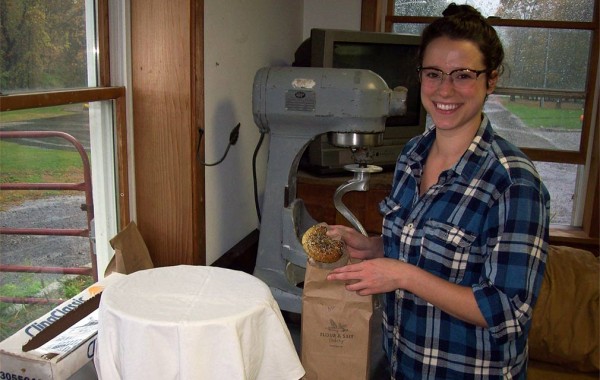Britty Buonocore ’12, MA’13
Britty Buonocore ’12, MA’13 taught middle- and high-school English for two years after graduation. Now back in Hamilton, she is the owner and head baker of Flour and Salt Bakery. She has pulled together some tricks of the trade that all novice bakers can use in their home kitchens when they’re in a bind.
If you’re like me, you’ll find that the moment suddenly strikes at 5 in the morning or 10 at night to whip up a batch of “Because I Feel Like It” cookies, an “It’s Monday” cake, or “The Sun is Shining and I Want” sticky buns. However, sometimes your home kitchen isn’t outfitted with all of the ingredients you need. Below are some tips for substitutions and tricks to make most baking ventures possible when your pantry might be lacking.
The buttermilk dilemma. Buttermilk can create rich, complex baked goods, but most people I know don’t have a quart of buttermilk on standby. When a recipe calls for this sour dairy product, there are in-a-pinch solutions. Buttermilk is a thick, acidic liquid that shares qualities with yogurt, sour cream, and milk with lemon juice or cream of tartar. My never-fail substitute is: for 1 cup of buttermilk, add a scant tablespoon of lemon juice to a measuring cup and top with 1 cup skim, low-fat, or whole milk. Stir and let rest for two minutes. If you need more than 1 cup, add an additional teaspoon of lemon juice for every additional cup of milk. Voila!
Wait! Does that say room temperature butter? Until you have baked regularly and have learned from your own absent-mindedness that most recipes call for room-temperature (68 degrees) butter, you may tend to forget this step. The correct butter temperature is crucial when making pastries, cakes, and cookies. Scientific information on this can be found online or in recipe books, and it’s fascinating, even to an English teacher. Here’s how to soften butter in a hurry: First of all, step away from the microwave! This melts rather than softens the butter. Instead, cut the butter into small pieces and spread the pieces out on a clean surface. Let them rest for about 30 minutes before using, if possible. You can also roll it in between two sheets of parchment paper to speed up the warming process. If you can easily press your fingers into the butter but it doesn’t turn into a melty mess, the butter is ready to work with.
Who even buys cake flour? Cake flour can be hard to find in grocery stores and is usually pricier than all-purpose flour. For all home-baking purposes, here’s your fix: Put 1 cup minus 2 tablespoons of all-purpose flour into a sifter. Add 2 tablespoons of cornstarch. Sift the mixture at least three times to aerate the flour and combine the ingredients. Follow the same procedure for any additional cups. Using this method gives you an airier, fluffier result for irresistible cakes.







